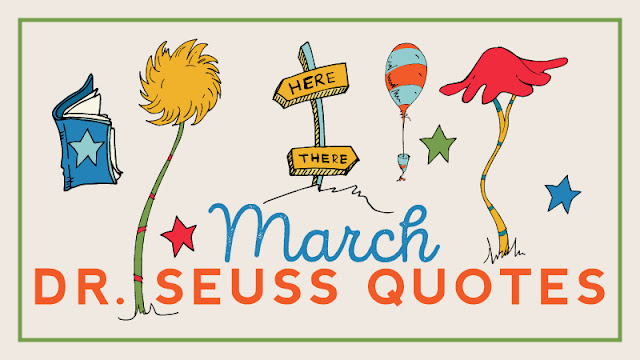Dr.
Seuss Book List
The books in the Dr. Seuss Book List are categorized
according to Dr. Seuss’s publishing company,
Random House’s divisions.
BEGINNER BOOKS in the Dr. Seuss Book
List
(Ages 4-8)
Beginner Books were originally created by Dr. Seuss in order
to encourage children to read all by themselves. He took a list of 223
easy-to-read words, found the rhyming ones and created a fun and
simple blend
of pictures and words. All Beginner Books have a picture of one of Dr. Seuss’s
most
famous character creations, the Cat in the Hat, on their cover.
The Cat in the Hat,
1957,
The Cat in the Hat Comes Back! , 1958
One Fish Two Fish Red Fish Blue Fish, 1960
Green Eggs and Ham, 1960
Hop on Pop, 1963
Dr. Seuss's ABC, 1963
The Cat in the Hat Beginner Book Dictionary, 1964 written with P.D.
Eastman
Fox in Socks, 1965
I Wish that I had Duck Feet, 1965 Illustrated by B. Tobey
Come Over to My House, 1966 Illustrated by Richard Erdoes
Wacky Wednesday, 1974 Illustrated by George Booth
Because a Little Bug Went Ka-choo, 1975 Illustrated by Michael Frith
Oh, the Thinks You Can Think!, 1975
The Cat's Quizzer, 1976
Please Try to Remember the First of Octember, 1977 Illustrated by Art
Cummings
I Can Read With My Eyes Shut!, 1978
Oh Say Can You Say?, 1979
I Am Not Going to Get Up Today!, 1987 Illustrated by James Stevenson
BEGINNER BOOK EXTRAS in the Dr. Seuss Book
List (Ages 4-8)
These Dr. Seuss books are not part of the main series of Beginner Books, but
are still considered to
be part of the Beginner Book Category by Random House.
And to Think That I saw it on Mulberry Street, 1937
The 500 Hats of Bartholomew Cubbins, 1938
The Cat in the Hat Song Book, 1967
My Book About Me, 1969, written with Roy McKie
I Can Draw It Myself, 1970
Maybe You should fly a Jet, Maybe You Should be a Vet, 1980 Illustrated
by Michael J. Smollin
Hunches in Bunches, 1982
Daisy-Head Mayzie, 1994
BRIGHT & EARLY BOOKS in the Dr. Seuss Book
List (Age Preschool)
Dr. Seuss created these books for the “beginning beginners”. With few, simple
words and colorful,
telling pictures the stories are fun and brief for the
youngest of kids.
The Foot Book,
1968
The Eye Book, 1968 Illustrated by Joe Mathieu & Roy McKie
Mr. Brown Can Moo! Can You?, 1970
In A People House, 1972 Illustrated by Roy McKie
Marvin K. Mooney Will You Please Go Now!, 1972
The Shape of Me and Other Stuff, 1973
There's a Wocket in My Pocket!, 1974
Great Day for Up, 1974
Would You Rather be a Bullfrog?, 1975 Illustrated by Roy McKie
Hooper Humperdink…? Not Him!, 1976 Illustrated by Charles E. Martin
The Tooth Book, 1989 Illustrated by Joe Mathieu & Roy McKie
The Pop-Up Mice of Mr. Brice 1989 Illustrated by Roy McKie
I Can Write, 1993 Illustrated by Roy McKie
BRIGHT & EARLY BOARD BOOKS in the Dr. Seuss Book
List (Ages Baby to Preschool)
As you can see, some of the titles here are the same as in the two categories
above. They are the
same Dr. Seuss stories published into sturdier books for
the youngest of the young.
One Fish Two Fish Red Fish Blue Fish
Ten Apples Up On Top, 1961
Hop on Pop
Dr. Seuss’s ABC: An Amazing Alphabet Book!
The Foot Book
The Eye Book
Mr. Brown Can Moo! Can You?
The Shape of Me and Other Stuff
There's a Wocket in My Pocket!
The Tooth Book
HARDCOVER CLASSICS in the Dr. Seuss Book
List (Ages 4-8)
While these books don’t fall into the Beginner Books category they do retain
their value to children
and parents. Many of these Dr. Seuss books contain
moral or ethical messages embedded in the funny stories.
The King's Stilts, 1939
Horton Hatches the Egg, 1940
McElligot's Pool, 1947
Thidwick the Big-Hearted Moose, 1948
Bartholomew and the Oobleck, 1949
If I Ran the Zoo, 1950
Scrambled Eggs Super!, 1953
Horton Hears a Who!, 1954
On Beyond Zebra, 1955
If I Ran the Circus, 1956
How the Grinch Stole Christmas, 1957
Yertle the Turtle and Other Stories, 1958
Happy Birthday to You!, 1959
The Sneetches and Other Stories, 1961
Dr. Seuss's Sleep Book, 1962
I Had Trouble in Getting to Solla Sollew, 1965
I Can Lick 30 Tigers Today! And Other Stories, 1969
The Lorax, 1971
Did I Ever Tell You How Lucky You Are?, 1973
The Butter Battle Book, 1984
You're Only Old Once!, 1986
Oh, the Places You'll Go!, 1990
My Many Colored Days, 1996 (posthumous)



























